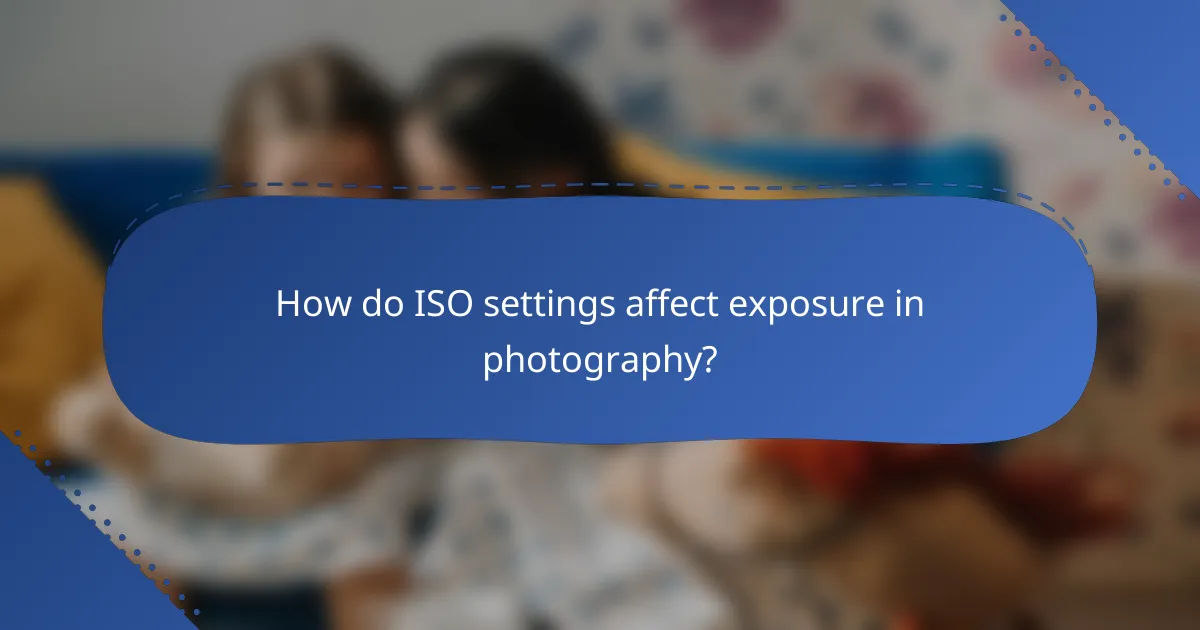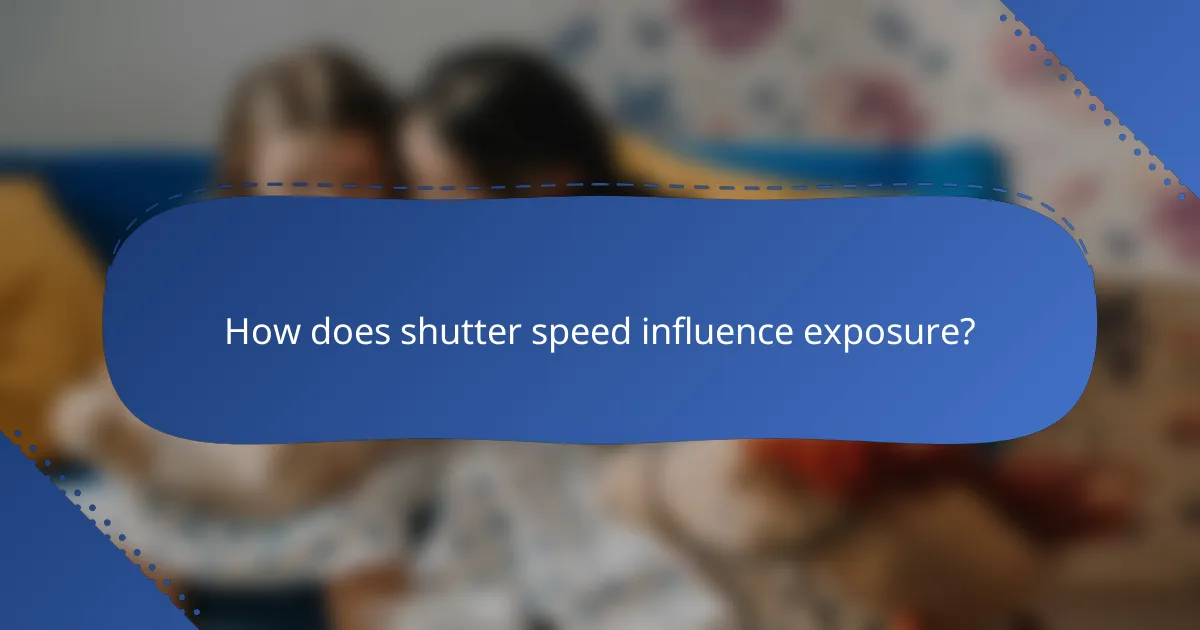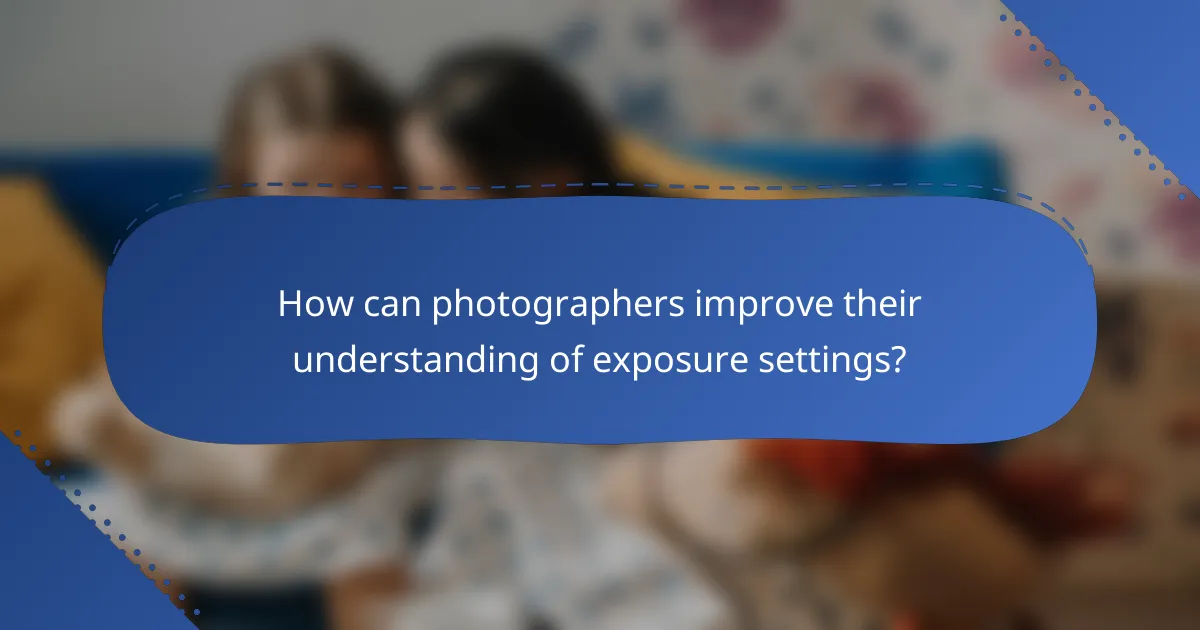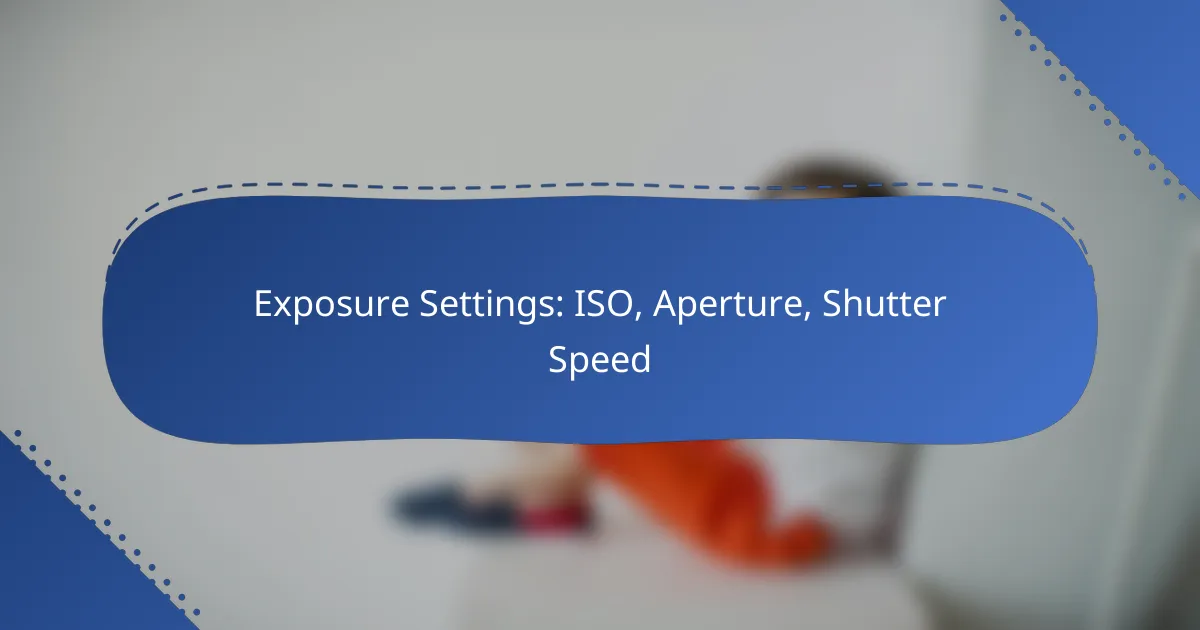Understanding exposure settings—ISO, aperture, and shutter speed—is essential for achieving the desired brightness and quality in your photographs. ISO adjusts the camera’s sensitivity to light, aperture controls the amount of light entering the lens, and shutter speed determines how long the sensor is exposed to light. Mastering these elements allows photographers to adapt to various lighting conditions and creative intentions.

How do ISO settings affect exposure in photography?
ISO settings directly influence the exposure of photographs by adjusting the camera’s sensitivity to light. Higher ISO values allow for better performance in low-light conditions, while lower ISO values help maintain image quality by reducing noise.
Higher ISO increases sensitivity to light
When you increase the ISO setting on your camera, it enhances the sensor’s ability to capture light, making it easier to shoot in darker environments. For instance, an ISO of 1600 or higher is often used in dimly lit situations, such as indoor events or nighttime photography.
However, while higher ISO settings can be beneficial, they come with trade-offs. The increased sensitivity can lead to more noise in the image, which can detract from overall quality. It’s essential to find a balance that suits your shooting conditions.
Lower ISO reduces noise in images
Using a lower ISO setting, such as 100 or 200, significantly reduces noise and graininess in your photos, resulting in cleaner and sharper images. This is particularly advantageous in bright lighting conditions or when using a tripod for long exposures.
While lower ISO settings yield better image quality, they require more light to achieve proper exposure. Therefore, in low-light situations, you may need to adjust other settings, like aperture or shutter speed, to compensate for the reduced sensitivity.

What is the role of aperture in exposure settings?
Aperture is a crucial component of exposure settings that determines how much light enters the camera. It is expressed in f-stops, where a lower f-stop number allows more light, while a higher number reduces light intake.
Aperture controls the amount of light entering the camera
The aperture setting directly influences the exposure of an image by regulating the light that reaches the camera sensor. For instance, an aperture of f/2.8 lets in significantly more light than f/16. Photographers often adjust aperture based on lighting conditions, using wider apertures in low light and narrower ones in bright environments.
When selecting an aperture, consider the scene’s brightness and the desired exposure. A good starting point is to use the lowest f-stop available for low-light situations, while higher f-stops can be beneficial in sunny conditions to prevent overexposure.
Aperture affects depth of field
Aperture not only controls light but also impacts depth of field, which is the range of distance in a photo that appears sharp. A wide aperture (like f/2.8) creates a shallow depth of field, blurring the background and isolating the subject, ideal for portraits. Conversely, a narrow aperture (like f/16) increases depth of field, keeping more of the scene in focus, which is useful for landscapes.
When planning your shots, think about how depth of field can enhance your composition. If you want to emphasize a subject against a soft background, opt for a wide aperture. For scenes where detail throughout is important, choose a smaller aperture to achieve greater sharpness across the frame.

How does shutter speed influence exposure?
Shutter speed significantly affects exposure by controlling the duration that light hits the camera sensor. A faster shutter speed allows less light in, which is ideal for bright conditions or freezing motion, while a slower shutter speed permits more light, suitable for low-light environments or capturing motion blur.
Faster shutter speed freezes motion
Using a faster shutter speed, typically around 1/500 of a second or quicker, can effectively freeze fast-moving subjects, such as athletes or wildlife. This technique is essential in sports photography or any scenario where motion clarity is crucial.
However, it’s important to balance shutter speed with ISO and aperture settings to avoid underexposure. For instance, if shooting in bright sunlight, a shutter speed of 1/1000 may be necessary to prevent overexposure while capturing sharp images of moving subjects.
Slower shutter speed creates motion blur
Slower shutter speeds, generally ranging from 1/30 of a second to several seconds, can create intentional motion blur, adding a sense of movement to images. This technique is often used in landscape photography to smooth out water or create light trails from moving vehicles.
When using slower shutter speeds, a tripod is recommended to prevent unwanted camera shake. Additionally, consider using a neutral density filter in bright conditions to extend exposure times without overexposing the image.

What are the best practices for balancing ISO, aperture, and shutter speed?
To effectively balance ISO, aperture, and shutter speed, photographers should understand how these three elements interact to achieve proper exposure. The goal is to find a harmonious setting that allows for clear images without introducing noise or motion blur.
Use the exposure triangle for optimal settings
The exposure triangle consists of ISO, aperture, and shutter speed, each affecting the exposure and overall quality of an image. A lower ISO reduces noise but requires more light, while a wider aperture allows more light but decreases depth of field. Adjusting shutter speed influences motion capture; faster speeds freeze action, while slower speeds create motion blur.
For optimal settings, start with a base ISO (typically around 100-400 for bright conditions) and adjust your aperture and shutter speed accordingly. For example, if you open your aperture to f/2.8 to allow more light, you may need to increase your shutter speed to avoid overexposure.
Adjust settings based on lighting conditions
Lighting conditions significantly impact how you balance ISO, aperture, and shutter speed. In bright daylight, a low ISO and smaller aperture (like f/8 to f/16) with a fast shutter speed (1/500s or faster) can prevent overexposure. Conversely, in low light, you might increase the ISO (800-3200), widen the aperture (f/1.8 to f/4), and slow down the shutter speed (1/60s or slower) to capture enough light.
Always consider the scene’s dynamics; for instance, if photographing a moving subject in low light, you may need to prioritize a faster shutter speed, even if it means increasing the ISO, which could introduce some noise. Balancing these settings requires practice and experimentation to find what works best for each unique situation.

What are common mistakes in exposure settings?
Common mistakes in exposure settings include overexposing images in bright conditions and underexposing them in low light. Understanding how to balance ISO, aperture, and shutter speed is crucial for achieving the desired exposure without losing detail.
Overexposing in bright conditions
Overexposing occurs when too much light hits the camera sensor, resulting in washed-out images. This often happens in bright environments, such as sunny days or reflective surfaces like water or snow.
To avoid overexposure, consider using a lower ISO setting, a smaller aperture (higher f-stop number), or a faster shutter speed. For example, an ISO of 100 or 200, combined with an aperture of f/16 or f/22, can help maintain detail in bright scenes.
Underexposing in low light
Underexposing happens when insufficient light reaches the sensor, leading to dark images with lost detail in shadows. This is common in low-light situations, such as indoors or during twilight.
To correct underexposure, increase the ISO, open the aperture (lower f-stop number), or slow down the shutter speed. For instance, using an ISO of 800 or higher, an aperture of f/2.8, or a shutter speed of 1/30 seconds can improve exposure in dim conditions.

How can photographers improve their understanding of exposure settings?
Photographers can enhance their grasp of exposure settings by actively engaging with their cameras and studying the work of experienced professionals. Understanding ISO, aperture, and shutter speed is crucial for achieving the desired exposure in various lighting conditions.
Practice with manual mode on cameras
Using manual mode allows photographers to have full control over ISO, aperture, and shutter speed. This hands-on experience helps in understanding how each setting affects exposure and depth of field. Start by experimenting with different combinations in various lighting conditions to see the immediate impact on your images.
Begin with a low ISO setting in bright light, adjust the aperture to control depth of field, and vary shutter speed to capture motion. A good practice is to take notes on the settings used for each shot, which can help in recognizing patterns and improving decision-making in future shoots.
Study examples from professional photographers
Analyzing the work of professional photographers can provide valuable insights into effective exposure settings. Look for images that resonate with you and try to identify the settings that may have been used. Many photographers share their settings on platforms like blogs or social media, which can serve as a learning tool.
Consider creating a reference folder of images with noted settings to compare how different exposure settings influence the final result. This practice not only enhances your understanding but also inspires creativity in your own photography.

What tools can assist in managing exposure settings?
Several tools can help photographers manage exposure settings effectively, including light meters, camera histograms, and exposure calculators. These tools provide valuable insights into how ISO, aperture, and shutter speed interact to achieve the desired exposure.
Light Meters
Light meters measure the amount of light in a scene, allowing photographers to determine the optimal exposure settings. They can be handheld or built into cameras, providing readings that help adjust ISO, aperture, and shutter speed accordingly. Using a light meter can significantly reduce the guesswork in exposure settings, especially in challenging lighting conditions.
When using a light meter, aim to take readings from different areas of the scene to gauge the overall light distribution. This can help avoid overexposed highlights or underexposed shadows, ensuring a balanced exposure.
Camera Histograms
Camera histograms display the distribution of tones in an image, helping photographers assess exposure after taking a shot. A histogram shows the brightness levels from dark (left) to bright (right), allowing for quick adjustments to ISO, aperture, or shutter speed based on the data presented. A well-balanced histogram typically has a range of tones without clipping on either end.
To use histograms effectively, check them after each shot and adjust settings as needed. Aim for a histogram that utilizes the full width without significant spikes at the extremes, indicating that details are preserved in both highlights and shadows.
Exposure Calculators
Exposure calculators are tools or apps that help photographers determine the correct exposure settings based on specific conditions. By inputting variables such as lighting conditions, desired depth of field, and motion blur, these calculators can suggest appropriate ISO, aperture, and shutter speed combinations. They are particularly useful for beginners or when shooting in unfamiliar environments.
When using an exposure calculator, consider the creative aspects of your shot. While the calculator provides a technical foundation, personal preferences for artistic expression may lead to adjustments in settings for desired effects, such as motion blur or shallow depth of field.
